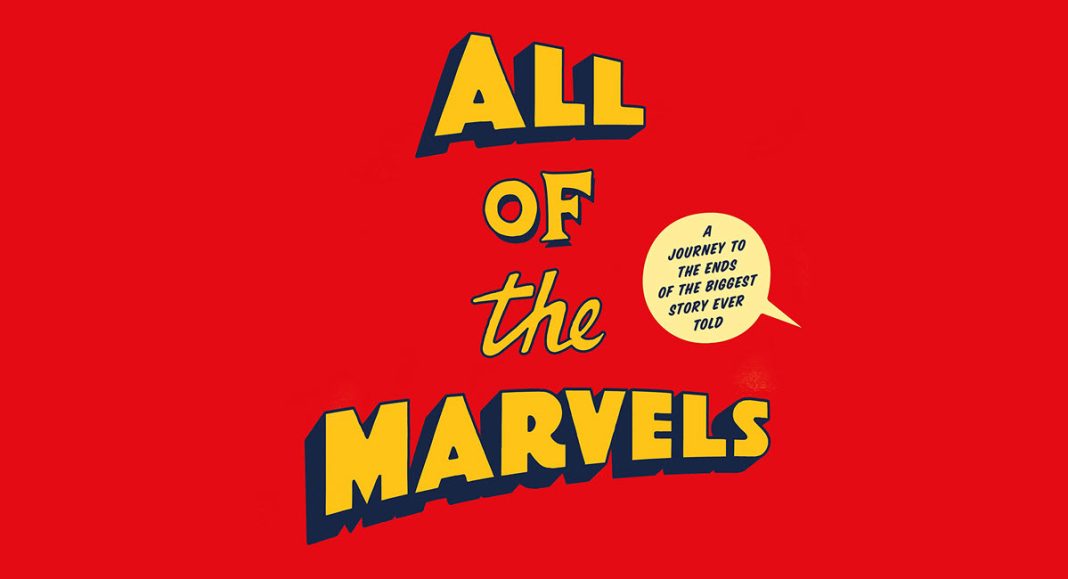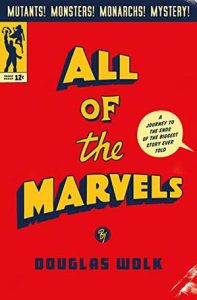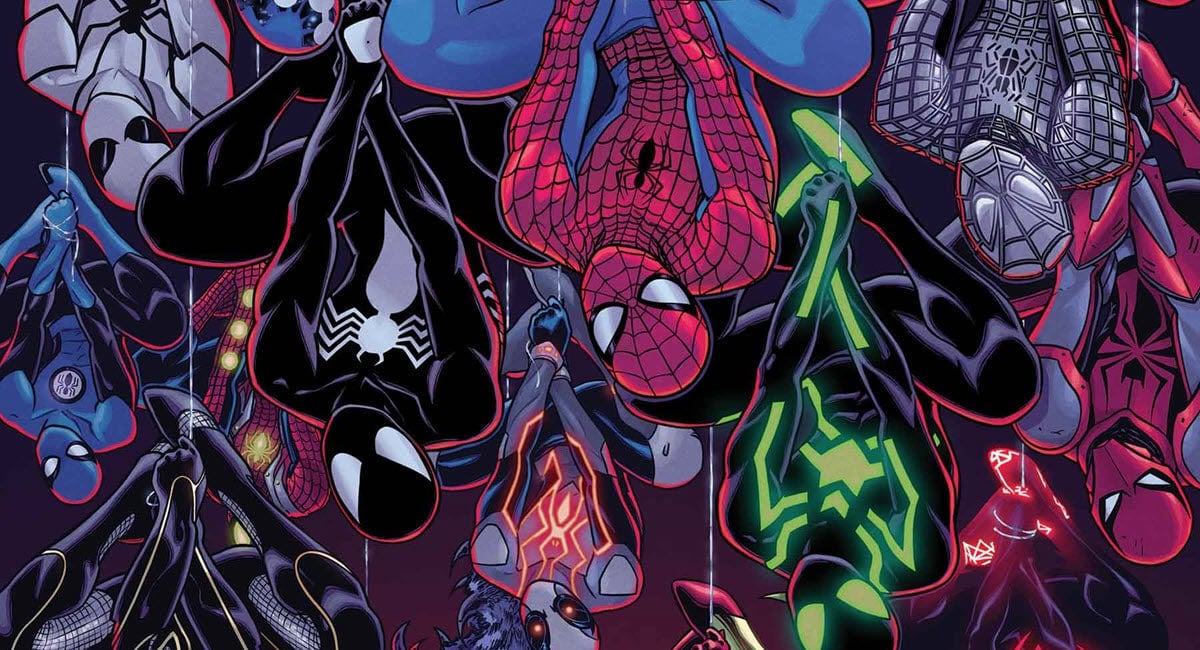When I first heard about noted comics thinker Douglas Wolk’s All of the Marvels project, my eyes got bigger and my brows raised like that meme girl drinking the kombucha. “This guy is reading every Marvel comic ever published AND he’s going to write a book about it? How fast can I possibly sign up?” I immediately followed Wolk on Twitter, tuned into his project’s tumblr posts, and patiently waited to hear more about the book that would chronicle, as its tagline read, the biggest story ever told.
My appetite was wheted even further when Wolk gave a talk at his local shop, Books with Pictures. Wolk broke down what he determined to be the core key players in Marvel history, and found a pretty engaging way to navigate Marvel’s ins and outs through their specific perspectives. I was riveted by the idea that I, as someone who has always been hot and cold on the Marvel Universe (I grew up on a steady diet of DC), might find a new perspective through Wolk’s longer-form work on the topic and what was starting sound like a “unified theory of Marvel”, whatever that means. I’m not sure Wolk necessarily promised such a thing, but one has to imagine after reading tens of thousands of comics from the early ’60s to today, you’d absolutely become some kind of guru on the topic. And I’m interested in what he had to say about it, be it either a first-hand account of the experience or a grander textual thesis.
I received my copy of All of the Marvels a few months back, and I couldn’t open it fast enough. That night before bed I laid down to get started on the intro, noting the Doctor Doom quote. I traipsed right into the intro passages, where Wolk began to explain his methodology and approach for the final output of the entire effort. A sense of disinterest quickly began to set in. Was it the long passages explaining to newbies fresh off the Marvel movies how comics universes work? Was it the footnotes that felt like they were overwhelming the main text on some pages? Or was it the creeping sensation that this was less of a grand statement and more of a reading guide for the uninitiated? I thumbed forward a few more pages, past the book’s general statement of purpose of what readers should and shouldn’t expect, and how you shouldn’t accept the book’s guideposts as an exact syllabus, and flipped through a few chapters to get a sense of what was to come. For the most part? Sections dedicated to specific Marvel teams or solo heroes, and with each, a sometimes chronological (though not always) listing of specific issues and some commentary by Wolk to provide some additional context.
I ended up putting the book down, tried to give it another shot a day later, and then set it aside to continue my personal fictional journey elsewhere. With the release date ticking down ahead of me, I felt that nagging obligation to say something, anything about this work, in written form. But I had no idea how to tackle it.
Finally, on vacation, my partner and I were at dinner and I spoke to her at length about my personal expectations for the book, and what it actually was: less a work of theory on its face, and really more a reference guide. She brilliantly, as she always does, recommended that I try to take the author’s approach as written, and choose a chapter and simply follow along. Determine if the method works. And dear reader, as somebody who knows just enough about the Marvel Universe to be dangerous, that was just the kick in the head I needed.
I decided to follow along with Wolk’s recommendations for his first proper entry, which centers on the Fantastic Four, a chapter he cleverly calls “the junction to everywhere”. Fitting really, as somebody once told me that every Marvel comic was a Fantastic Four spinoff. Was that the late Tom Spurgeon? We’ll say yes.
Wolk’s approach to FF is pretty interesting, as his choices focus less on the big events of Marvel’s first family that everyone talks about – there’s nary a Galactus or Silver Surfer to be seen – and instead zeroes in on their growth as a family. The very first issue you’re set to read is Kirby and Lee’s #51, “This Man, This Monster”, as perfect a Silver Age comic as you’re going to find. From there we hop around to Reed and Sue’s wedding, the birth of Franklin Richards, and eventually a wonderful example of John Byrne’s retroactive continuity in a tale that leads up to that fateful rocketship ride that was basically the Marvel Universe’s big bang event. Then and only then does he recommend reading Fantastic Four #1. All the while, as I was gulping down these comics in quick succession and then reading Wolk’s passages for each, it was a bit like having my own private comics club with the grand poobah of Marvel knowledge. I was particularly tickled by a stretch of FF–Doctor Strange–Avengers West Coast issues that built off of each other like mini-Back to the Future sequels.
Having read that chapter and all of its associated issues to completion, I suddenly got very juiced up about the book. Whether or not Wolk’s writing had as much to do with it as just reading the comics themselves, it was refreshing to have a guide holding my hand through the FF that didn’t read like any other “essentials” article one could find. While I found it pretty hard to not just keep reading Walt Simonson’s run, I felt surprisingly satisfied by my newfound growing knowledge of a property that was acquired through reading just 16 issues of comics (along with the background information provided by a guy who knows way more than I ever will on the subject).
It should be noted, Wolk also peppers interstitial chapters between each larger guide to help provide further coloring for the overall Marvel experience. For example, following a reader’s sojourn with the Fantastic Four, they’ll be treated to a timeline that fleshes out the history of giant monsters in the publisher’s catalogue. Nothing anyone truly needs to know, but an extra fun wrinkle that, once you understand the connection, really enriches your appreciation for Jack and Stan’s first ride with Reed, Ben, Sue, and Johnny.
To be honest, I was tempted to stop there. But knowing that everyone’s favorite wallcrawler beckoned, and that I was currently on my own big time binge with Mr. Parker (the magic of enticing movie trailers!), I had to move forward. And while Wolk advertises his Spider-Man reading list as being spun like a web, it really is a much more chronological approach. Spider-Man is tougher than his pals in the Fantastic Four, because for one, it’s (mostly) the journey with one guy at the center. And whereas the previous chapter was very focused on new life, so much of Spidey’s history is tied to death — the death of his loved ones, the death of his villains, even his own death a few times — and those issues are mostly accounted for. Wolk doesn’t have readers spend as much time with Lee, Ditko and Romita as you might expect, and Roger Stern doesn’t even happen at all to my surprise. But what’s here is deeply rooted in Peter’s personal growth, and what Wolk terms as the numerous cycles of Spider-Man’s overall narrative, a demarcation where everything Peter has built up to at that point quickly tumbles. I can’t say I had ever thought of Spider-Man in those terms, but as I kept working my way through, I suddenly was starting to feel like a bit of a Spidey scholar, ready to impart Wolk’s knowledge on anyone who would listen.
To detract somewhat, there are a few curious inclusions in these sections that don’t totally work. For the Fantastic Four, Marvel Legacy #1 is a pretty limp way to close out what was largely a rousing selection of comic adventures. With Spider-Man, the back half is very Dan Slott heavy — which for the record I was really enjoying reading (and can’t wait to read “Brand New Day” from its beginnings on through) — but snapshots of his run don’t work quite as well, and there are elements that Wolk doesn’t explain, like why is Miguel O’Hara/Spider-Man 2099 in the present? How did that happen? And I can’t even begin to explain how befuddled I was by the issue of Ultimate End that’s listed.
But that speaks to some of the challenge of a project like this anyway. As comics began to focus more and more on the book market and the collected edition, being able to pull off a satisfying reading experience in the middle of an ongoing story was going to be a tough task. Wolk does an admirable job of it with the materials he has to work with, and I should say I came out of the Spider-Man chapter with not only a greater and stronger understanding of Peter Parker and his ever-tragic life, but also just how strong his core supporting cast really is. Arguably, the best in comics (sorry Bat-fans).
From there, Wolk provides some good, albeit brief, history on the working relationships of Lee, Kirby and Ditko. For what it’s worth, he does give the most even-handed take on Lee’s contributions to their collaborations that I’ve read in a while. Again, the interstitials enrich the experience, and that’s something that I’m now looking forward to reaching in subsequent chapters.
So yes, this is really an incomplete review, but this is the only way I could approach what Wolk was doing. I wish I had figured it out earlier, but I have what looks to be some really exciting reading ahead of me with chapters on Shang-Chi, X-Men, Thor, Black Panther, Iron Patriot/Norman Osborn, Jonathan Hickman’s big megastory, and the younger, emerging heroes that have captured new readers’ hearts and minds (namely Ms. Marvel and Squirrel Girl).
What have I learned so far about All of the Marvels? I can’t say I know exactly who the intended audience for the book is, a question I hate that I’m even asking. Based on the intro, the author seems to think it’s geared towards comics newcomers. But the likelihood they’ll pick up a book like this, rather than just read whatever is new and within their interest, is not high. Is it for long-time Marvel readers? It’s definitely a refreshing look at old saws, and once you get into the meat of it, there may be value for even the most hardened Marvel heart. But ironically, I think the perfect reader for the actual project is someone like me, a casual Marvel reader looking to grasp a greater sense of its history and clear their own blindspots. I wouldn’t have predicted that a few months ago.
Regardless, whatever your background on the subject, I highly recommend this as an experiment you take a hands-on approach to instead of reading in a vacuum, which was a far less satisfying experience. Have Marvel Unlimited, or whatever your reading equivalent, well in hand as you begin this guided exploration through one of the great narrative achievements in pop culture.
Douglas Wolk’s All of the Marvels is in stores tomorrow.








